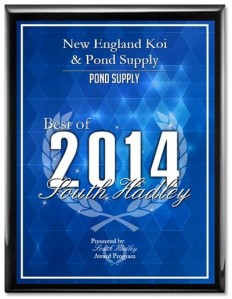Preparing your pond and your fish for winter in the colder parts of the country, such as us in New England, is a very important part of Koi keeping. Freezing temperatures can be extremely detrimental to Koi and, in my experience, the bigger they are the harder they winter over. Temperatures below 35-36 degrees fahrenheit at the bottom of the pond has almost always resulted in problems and losses.
For us, preparation usually begins around the middle of September when water temperatures are in the 60's. Food is changed to a high quality all season blend with feedings and amounts curtailed as water temperatures decline according to usual recommended feeding guidelines.
Ponds must be clean if you want to successfully winter over your fish. While the whole eco-system certainly slows down, it does not end, and harmful wastes will be generated with little or no biological activity available to process that waste. Reduce the organic load by cleaning. Cover the pond to keep out leaves and vacuum if needed. Add beneficial bacteria and other natural products that are designed to break down organics. Do large water changes using appropriate conditioners when the pond water temperature is close to the temperature of your water source. Check and adjust your PH and alkalinity if necessary. Both should be monitored and adjusted all winter. Remember, biological activity has slowed down a great deal, but has not stopped.
If you can, check for signs of parasites and bacterial problems and treat now. If you use salt, bring it to 0.3%, OR, do what we do, treat for parasites using a broad spectrum product following the manufacturer's instructions. Incidently, I do not use salt in my outdoor pond.
If your pond is likely to freeze over, you need to keep a small area open to allow harmful gases to escape. Airstones are the most common method, but at around 10 degrees they don't work well, but will form some lovely stalagmites. What has worked well for us in the past is as follows:
Make a simple frame using 2 inch PVC glueing all corners together. This will float. Attach an airstone to it and place a deicer in the middle. Attach this to shore using some stakes and rope. Place it where you want it and plug it in.
Where do you want it? The airstone needs to be below the surface of the water, but no deeper than one-third of the depth of the pond. We don't want to boil the surface of the water, so keep the volume of air adjusted so that it just breaks the water surface or rolls it over. In the winter the warm water is on the bottom, which is where the fish will be, and we don't want heavy circulation that may alter this stratification.
Why do all this you ask? When the water cools off everything slows down, the good bugs, the bad bugs and your fishes immune system. The problem is that when things warm up in the spring the bad bugs wake up before the good bugs and the immune systems. So do something to prepare for winter to optimize your fishes health and minimize the stress that is associated with these cold water conditions. Besides that you will have to clean in the spring anyway so why not do some of this in the fall.


